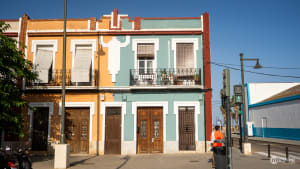
La Crida
This is the proclamation of the Fallas’ official beginning: how a city enters three weeks of celebration, colour, noise, and spectacle.
La Crida in a nutshell…
La Crida is the official proclamation that marks the start of Fallas in Valencia, calling locals and visitors to embrace weeks of celebration, fire, and tradition.
Location: Plaza de la Crida, in front of the Serranos Towers.
Time: Held on the last Sunday of February, starting at 7:30 PM.
Entry: Free to attend, but large crowds gather early for the best spots.
Main Attractions: Speeches by the Fallera Mayor, the Fallera Mayor Infantil, and the Mayor of Valencia, followed by fireworks, music, and a light show.
The Crida (sometimes called Cridá) is a public proclamation that kicks off the most intense days of Fallas in Valencia. As such, it is one of the most eagerly awaited Fallas events, because it starts the festival as it is generally intended - the days between the end of February and the 19th of March. The Crida is the mark that, after a year of preparation and trepidation, everything is about to reach its climax and its end.
The key moment in the ceremony is the Fallera Mayor’s speech, in which she invites all people to get to know the festival and to enjoy it. In fact, the word Crida, in Valencian, means “call”.
This ceremony, officiated every year on the last Sunday of February, is exactly this: a call to gather everyone, to honour and welcome the festival as its time approaches once again, after a year spent in anticipation.

During the Crida the city, its inhabitants, its visitors, and its falleros are called to participate in the Fallas, celebrate, and have fun. This ceremony is the sign that the city is about to be taken by a storm of colours, joy, and fireworks, a sign that people will soon be able to see spectacular fallas sculptures in the streets and witness magnificent pyrotechnic displays.
As the sky explodes in dozens of colours and shapes around the Serranos Towers, the city enters its most extravagant celebration. After this night, people can say that Valencia está en Fallas (Valencia is under Fallas).
What Is It Exactly
Although it is preceded by a series of preparatory events, the Crida proper begins in the evening, around 8:00 pm. Thousands of falleros from all over the city flock to Plaza de la Crida, in front of the Serranos towers.
All the Fallas committees - each with their banner and their members - gather here. As they wait for the officiating figures to climb up the scaffolding attached to the Torres de Serranos, there usually is music, singing, fireworks, and a light show. There might even be dancing or small theatrical performances.
Finally, the Falleras Mayores (the Fallera Mayor and the Fallera Mayor infantil) and Valencia’s mayor arrive. Once they are in front of everyone on the platform, they each give a short speech in Valencian to encourage people to celebrate and wish good luck to the year’s Fallas edition.
These are considered the most moving moments of the function. The mayor goes first, handing the city’s keys to the Fallera Mayor in a symbolic gesture. After that, she gives a speech too, followed by the Fallera Mayor Infantil.
At this point, all the gathered falleros sing the Valencian anthem, as well as a piece of the Spanish anthem. Once finished, the grand finale consists of a firework display and light show set off from the old Turia riverbed (the Turia Park).

Parade to Plaza de la Virgen
After the ceremony, the crowd, made up of the municipal authorities, the Fallas Council and the Falleras Mayor and Infantil with their respective courts of honour, make their way to the church in Plaza de la Virgen.
The point of the parade to the Basilica de la Mare de Deu dels Desamparats is to pay homage to the Virgin Patron Saint of Valencia and request a favourable and smooth festivity.
Fallas Program for La Crida Day
Although the Crida in and of itself is the event that takes place in Plaza de la Crida, in front of the Serranos Towers, the whole day is occupied by preparatory celebrations. Here is a breakdown of what happens every last Sunday of February.
07:15 am - Despertà Infantil.
The young falleras and falleros of Valencia parade around the city, setting off loud firecrackers on the occasion of the despertà infantil.
07:30 am - Macrodespertà
Hundreds of falleras and falleros parade around the city, setting off loud firecrackers, followed by marching bands for the macrodespertà. This is concluded in Plaza del Ayuntamiento for a final, loud display called Disparà.
12:00 pm - Music bands.
The bands march to Plaza del Ayuntamiento in preparation for the Mascletà.
2:00 pm - Mascletà
At Plaza del Ayuntamiento, the first Mascletà of the year celebrates the Fallas days to come with a loud pyrotechnic display.
7:30 pm - Cridà
The proclamation of the Fallas, where Valencia’s mayor and Falleras Mayores give their speeches at the Torres de Serranos before another firework display. The crowd then walks to the Basilica de la Mare de Deu in a parade to the Virgin.
8:30 pm - Parade to Plaza de la Virgen
After the Crida, the crowd walks to the Basilica de la Mare de Deu.
Our recommendations
If you want to secure first row spots to see the Crida ceremony, we recommend you arrive early, as the event attracts a lot of people. There is no entry ticket, so you can be there as early as you like.
If you’d like to have a more detailed Fallas calendar, you can have a look at our dedicated article.
Location
The Crida ceremony nowadays takes place on the northern side of the Serranos Towers, facing Turia Park. The fireworks are fired towards the park.
Keep in mind that on the day of the Crida there will be traffic cuts and there might be changes to the bus routes.
Curiosities
In this section you can learn more about the name of the event and its common misspelling, as well as find out how the Crida changed drastically through the years, going from a donkey-riding proclamation to a ritualised ceremony.
Donkey Rides, Marching Bands, and Official Ceremonies
Nowadays, the Crida follows a specific formula, defined by a few components: the time, the place, the order of the ceremony, and the language (Valencian). But none of these elements has always been set in stone.

In the beginning, the Crida was not even called that, but simply Pregón (Proclamation). During the first Pregón, in 1931, the marching bands surrounded the city and marched towards Plaza del Ayuntamiento announcing the beginning of the festivity.
After the Spanish Civil War (1939), came a period characterised by ostentatiousness and exaltation of authority. The proclamation was moved directly to Plaza del Ayuntamiento and government representatives increasingly participated in the ceremony.
A funny exception to this pomposity was the year 1944, when a bellman rode through the streets on a donkey and recited the proclamation.
In 1954, the Crida was held at the southern side of the Serranos Towers for the first time, in an attempt to attract the growing Fallas tourism and diminish the aristocratic tone the ceremony had had until then.
After much protesting, in 1969, the proclamation was spoken in Valencian for the first time, instead of Spanish. In 1990 (after a pyrotechnic accident the year before) theCrida was moved to the northern side of the Serranos Towers, which allowed for more evacuation routes and safety. In 2016, a Fallera Mayor Infantil gave her own speech at the Crida for the first time.
Cridá or Crida?
You’ll often see the word indicating the ceremony written as Cridá. However, the correct spelling in Valencian would be Crida, with no accent (meaning proclamation in English).
The mistake comes from the fact that many words, which in formal Valencian are longer (mascletada, plantada, etc…) are often shortened in their informal version (mascletà , plantà, etc..). In Spanish, they take this accented form (with the correct Spanish accent), becoming mascletá, plantá, etc…
However, the Valencian word Crida (not cridada) is already short in formal Valencian, so it needs no adaptation in either informal Valencian or Spanish.
Frequently Asked Questions
Here you can find quick answers to all of your questions. Linked, you’ll find the articles or the sections of the articles that can give you more detailed information.
-
The word Crida is Valencian for “act of calling”. It is a call for the city and visitors to participate in the Fallas festival.
-
The Crida is celebrated on the last Sunday in February at 8:00 pm.
-
The Crida is celebrated in Plaza de la Crida (in front of the Serranos Towers).
-
No, throughout the years the Crida has taken place in many different locations (all over the city, Plaza del Ayuntamiento, the southern side of the Towers).
-
The Crida is one of the most important events in the Fallas festival. It represents the official beginning of the Festival that the committees have been preparing for a year.
-
The event is often referred to as Cridá, but technically, its correct name is Crida.
You can learn more about this in the relevant section of this article.
-
No, there are many events that come just before or after the Crida. Before the Crida you have the morning despertà, the marching band, and the mascletà in the afternoon.
Following the Crida there is a procession to Plaza de la Virgen.
You can see the schedule for that day in the relevant section of this article.



















